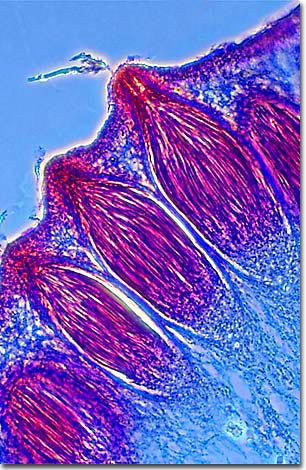Phase Contrast Image Gallery
Ergot (Claviceps purpurea)
Ergot, also known as Claviceps purpurea, is a parasitic fungus that has played a prominent, if notorious, role in human history. It's a disease of cereal crops and grasses, affecting grains such as wheat, barley, and oats, but most readily attacks rye and triticale.

The phase contrast image above illustrates mature stroma with perithecia of Claviceps purpurea in rye tissue. Although the fungus damages crops by destroying the grain kernel, it's best known for the poisonous effect it has when animals or humans eat ergot-contaminated grain.
Ergotism, a condition sometimes called St. Anthony's Fire, is caused by toxic doses of alkaloids produced by purple masses of spores called sclerotia. The condition is characterized by two sets of symptoms -- gangrene with burning pain in the extremities and convulsions, hallucinations, severe psychosis, and death. It can also cause miscarriages in both humans and animals.
During the Middle Ages, rye was a common grain crop in Europe. Cold, damp growing conditions in that region promoted growth of the fungus on the rye and caused repeated epidemics of St. Anthony's Fire, which -- at the time -- were attributed to witchcraft and satanic influences. It wasn't until the seventeenth century that ergot poisoning was identified as the cause of St. Anthony's Fire.
Although ergot derivatives can be toxic in high doses, they do have medicinal uses. Midwives were the first to discover its medicinal properties hundreds of years ago, using small doses of ergot extract to hasten labor or prevent postpartum bleeding. Ergometrine is the compound responsible for those effects, and is still being used to treat women in childbirth.
Ergotamine, another ergot derivative is valuable as a vasoconstrictor (restricting blood flow to the extremities) and is being used in medicines for the treatment of migraine headaches.
Adding to its notoriety, ergot is the source of lysergic acid, which is used to manufacture the powerful hallucinogen lysergic acid diethylamide (LSD).
BACK TO THE PHASE CONTRAST GALLERY
